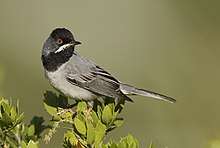Rüppell's warbler
| Rüppell's warbler | |
|---|---|
 | |
| Scientific classification | |
| Kingdom: | Animalia |
| Phylum: | Chordata |
| Class: | Aves |
| Order: | Passeriformes |
| Family: | Sylviidae |
| Genus: | Sylvia |
| Species: | S. ruppelli |
| Binomial name | |
| Sylvia ruppelli Temminck, 1823 | |
| Synonyms | |
|
Sylvia rueppelli | |
The Rüppell's warbler (Sylvia ruppeli) is a typical warbler of the genus Sylvia. It breeds in Greece, Turkey and neighbouring islands. It is migratory, wintering in north east Africa. This is a rare vagrant to western Europe. The name is occasionally cited as "Rueppell's warbler".
It is a typical "sylvia" warbler, similar in size but slimmer than Sardinian warbler. The adults have a plain grey back and paler grey underparts. The bill is fine and pointed, with brown legs and red eyes. The striking male has a black head and, usually, a black throat, separated by a white malar streak ("moustache"). Females have a pale throat, and the head is grey rather than black. Their grey back has a brownish tinge. The song is a slower, deeper rattle than that of Sardinian warbler.
Together with the Cyprus warbler it forms a superspecies with dark throats, white malar streaks and light remiges fringes. This in turn is related to the species of Mediterranean and Middle East Sylvia warblers that have a naked eye-ring, namely the subalpine warbler, Sardinian warbler and Ménétries's warbler. Both groups have a white malar area, but this may not form a clear streak in the latter group; above the white, the heads of males are uniformly dark.[2][3]
These small insectivorous passerine birds are found in thick thorny shrubs where they build their nests and lay four to six eggs.
The English name and the specific ruppelli commemorate the German zoologist and explorer Eduard Rüppell (1794–1884). The genus name is from Modern Latin silvia, a woodland sprite, related to silva, a wood.[4][5]
References
- ↑ BirdLife International (2012). "Sylvia rueppelli". IUCN Red List of Threatened Species. Version 2013.2. International Union for Conservation of Nature. Retrieved 26 November 2013.
- ↑ Helbig, A. J. (2001): Phylogeny and biogeography of the genus Sylvia. In: Shirihai, Hadoram: Sylvia warblers: 24-29. Princeton University Press, Princeton, N.J. ISBN 0-691-08833-0
- ↑ Jønsson, Knud A. and Fjeldså, Jon (2006): A phylogenetic supertree of oscine passerine birds (Aves: Passeri). Zool. Scripta 35(2): 149–186. doi:10.1111/j.1463-6409.2006.00221.x
- ↑ Beolens, Bo; Watkins, Michael (2003). Whose Bird? Men and Women Commemorated in the Common Names of Birds. London: Christopher Helm. p. 294.
- ↑ Jobling, James A (2010). The Helm Dictionary of Scientific Bird Names. London: Christopher Helm. pp. 341, 376. ISBN 978-1-4081-2501-4.
